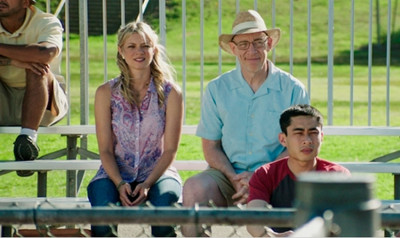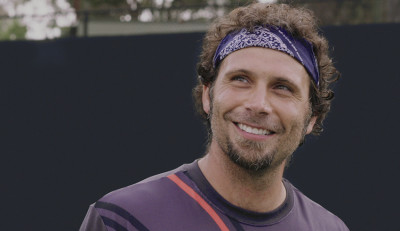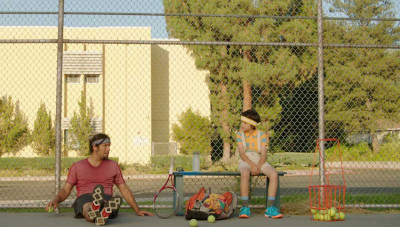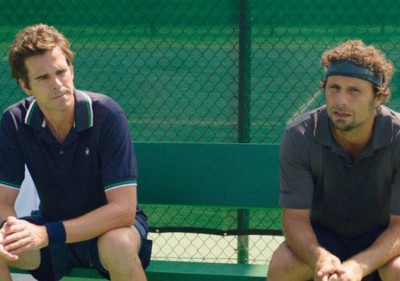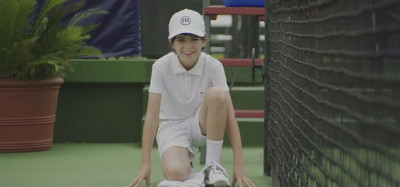It’s Game, Set, Match for “Break Point”! For many, the game of tennis can be as boring as watching paint dry or a ball endlessly bounce. For others, it’s an exciting, riveting, emotionally charged sport with nuance, intelligence and skill. What that means is that making a film set in the world of tennis is pretty much going to fall on one side of the bet or the other. In the case of “Break Point”, it’s definitely the latter as co-writers Jeremy Sisto and Gene Hong together with director Jay Karas deliver one of the most engaging and entertaining “sports based” films made, especially one set in the world of tennis. And it’s thanks to the nuance and intelligence of the story, well defined characters, well-crafted visual metaphor, and dynamic performances that “Break Point” has that little extra spin that scores an ace every time.
In their youth, brothers Jimmy and Darren Price were one of the best junior doubles teams in the United States with the potential to become the best in the world. Unfortunately, the always edgy and impatient Jimmy didn’t want to continue on the tried and true play he and Darren had developed. No, Jimmy is so hungry for titles and championships that he dumps Darren and partners up with someone else. Worst part is that not only did the partnership of Jimmy and Darren fall apart, so did their relationship as brothers.
Now decades later, Jimmy finds himself as the bad boy of the tennis circuit and in need of a partner if he is going to have one final fling at the as yet unattained championship glory. Having been dumped by every doubles player on the tennis circuit, Jimmy has no alternative but to grovel and beg Darren to return to play with him in a bid to qualify for the US Open. Now working as a substitute teacher, but for the occasional pick-up game, Darren has long moved on from tennis, but deep down he still longs for the closeness he once had with his brother.
Ultimately agreeing to partner up with Jimmy, Darren has his work cut out for him when it comes not only training and getting Jimmy back into fighting shape (seems Jimmy has spent more time with wine and women of late than on the tennis court), but getting their once perfect rhythm back in sync, a rhythm that only comes with the closeness of brothers, could be beginning of the end.
With some well placed parental advice from their veterinarian father Jack, and unbridled enthusiasm and encouragement from the always fashionable and color coordinated Barry, a young student of Darren’s who has attached himself to the brothers as his “mentors” for the summer, every lob, let, net, fault, ace, point, game and match plays out on multiple levels before our eyes.
Let’s face it ladies. Jeremy Sisto is hotter than hot as Jimmy; clearly taping into the John McEnroe bad boy of tennis persons while adding his own level of sweaty sex appeal and humor. You love Jimmy and you love to hate him all at the same time. BUT, there is never a moment you don’t believe who Jimmy is and the sibling relationship with David Walton’s Darren. Walton is really an ace for “Break Point” given that in addition to a skilled actor, he is an amateur tennis player and boasts a USTA rating of 5 out of 7. Walton brings the welcome and necessary “nice” factor to the sibling rivalry.
JK Simmons is sage perfection as Jack. Kind, matter-of-fact and inherently parentally funny, Simmons is a delight with rock solid parental grounding that rings true and touches the heart. Hilarious”divine” moments from the good Adam Devine as fellow player Nick, while as Gary (rival to the affections of Darren’s wanna be girlfriend) Vince Ventresca still plays beautifully as the arrogant-ass type boyfriend that we cherish and remember from “Romy & Michelle’s High School Reunion”.

But it’s Joshua Rush as Barry who steals the entire film, and your heart, and never more so than in third act going toe-to-toe with Sisto. On screen for more than 50% of the film, much of the story and the humor falls on Rush’s capable shoulders and he never drops the ball. Adding another layer to the story is Barry’s journey which runs parallel to that of Jimmy and Darren, intersecting and being influenced on one another along the way. Watching Rush’s Barry navigate the treacherous waters of finding himself as Jimmy and Darren find themselves, is a joy.
According to director Jay Karas, “Tennis was the way in. It’s the two brothers deciding to make a run in doubles tennis and they realize at a certain point that in order to be in sync as players, they have to be in sync as brothers and as human beings. . . At its core, it’s a story about brothers repairing relationships. You can take away the tennis and drop it into any scenario. The doubles tennis thing just happens to work really well because they have to work together and they have to be able to communicate in a really interesting, non-verbal, physical way.” Taking this beyond a “tennis movie” or “sports movie”, is not only the idea of brothers reconnecting, but just people connecting. As Jeremy Sisto sees it, “There’s not anyone, I don’t think, in this world that doesn’t have at least person that they’ve had some issues with. Those issues seem bigger than they actually are. And when they get into the room with that person, those issues reveal themselves to be most concocted in the mind. . . A lot of that is very human and relatable. Then on top of that you have a kid like Joshua Rush and a character [like Barry] that is so unique – and everyone can relate to being an outsider as a kid, even if you were the most popular kid in the school there was still an element of growing up.” With story and script by Jeremy Sisto and co-writer Gene Hong, the story is well defined and the characters and the sibling relationship between Jimmy and Darren beyond believable. Stand out is the character development and the emotional growth of each, resonating on every level.
Credit to Sisto and Hong for the depth of character in “Break Point”, most notably with Jimmy and Barry, and the development of their relationship. As described by Sisto himself, “Jimmy is a kid. He’s a kid and he’s a kid who needs to grow up because we all need to grow up. I think down deep he’s really worried that he can’t actually do that; that he won’t be able to grow up. He knows he can operate within the world that he lives in now, but he just doesn’t know if he can do that if he grows up. I think finding Barry and finding somebody to mentor and to coach and obviously finding a ‘brother’ is allowing him to get to the next stage of life.” Hand in hand with Jimmy is Barry who, like Jimmy, marches to the beat of his own drummer. The one difference is how each deals with being “the outsider” and that becomes the connective tissue for growth. Sisto is quick to describe the best of Barry, a fish out of water with no friends, but that’s okay because “To watch this character, it’s not that he doesn’t care. He knows he’s different. He leans into the curve. His personality is so much bigger than any of the emotions that would make someone feel badly about being an outsider. I think that is a super inspiring quality to watch. We see kids who are outsiders and you go, ‘Oh, I feel so bad for them’. You feel like that at times here, but mainly you’re like, ‘Oh, I feel bad for…..Oh, wait! He doesn’t care and he’s actually cool with who he is.” And now that he has a couple of male figures, a couple of strong figures in his life, he’s even better.
And the dialogue throughout is beyond sharp and witty, especially that of Sisto’s Jimmy and Joshua Rush’s Barry.
But what brings those characters and their journey to life are the film’s visuals which allow the story to unfold without distraction. Employing Sidney Lumet’s philosophy of “designing and creating visual metaphor for wherever you are in the film”, Karas and cinematographer Jim Frohna developed a specific map for lighting and lensing. “When we first meet Jeremy Sisto’s character Jimmy Price, he’s all over the place. He’s a loose cannon. He’s a mess. So the camera work should be handheld and a little bit loose to match Jimmy. When we first meet Darren, he’s sort of introverted and inward and put upon and very stoic and static and staid and the shots should match that. . . It was figuring out where we are with their relationship and designing the camera work around that. The added layer of aesthetic complication was figuring out how to shoot the tennis stuff and tracking that as well. Each tennis match had some key story points to follow and it also had to track in terms of the visual metaphor of where they were in their relationship and not just about the game. The game was the metaphor for how the brothers were doing in repairing their relationship.” The result is engaging and entertaining and filled with poignancy and laughter. “Break Point” is first and foremost a story of people and connection and reconciliation with sports a mere backdrop.
Frohna’s cinematography stays tonally light, refreshing and engaging while adding interest to his lensing of actual tennis matches with Sisto and Walton and various competitors, including some pro doubles who showed up to add even further authenticity. Complementing the visual design of Karas and Frohna, and particularly that of the tennis matches, is the editing by Seth Clark and Brad. E. Wilhite. Fabulous use of slo-mo, dutching and close-ups, not to mention a killer ball drop shot onto the camera lens by Walton’s Darren.
Interesting is Karas’ approach to blocking and shooting tennis play. As comes as no surprise, while one can get actors to hit their mark, getting a tennis ball to do the same is something else, especially when a plot point is reliant upon a specific shot in a game. As Karas analogizes, “If you take a regular scene that has some funny elements to it, you’ve got what you have on the page and you shoot that. Then you can let the actors improv and you can continue to refine and build the scene further that way. I approached the tennis the same way. I had overhead print outs of tennis courts and I drew out how you would draw out football plays. I drew out the specific points that I knew I needed and then made a shot list around that. I knew that if I only got that at a minimum I would have what I thought were the pieces I needed to put the matches together. But then, on top of it, in each scenario, almost all the tennis scenarios, we had the guys just play also. I shot in each camera set-up, like when I was on a wide, we got that point where the ball needed to go, now just play. And I’d shoot for 5 or 10 minutes of them playing. And I’d go into close-up and do the same thing. When we were in the two-shot, we’d do the same thing. So I just banked a bunch of extra tennis footage. To say it came in handy is a tremendous understatement.”
Reflective, Karas opines that while “it was a lot of work putting it together, a lot of work shooting it and we wanted to just make it feel very real, too”, key is that “ We didn’t use any stunt doubles in any of the tennis. There’s no digital balls. It’s all real.”
“Break Point’s” got all the balls in its court this Labor Day weekend! Let’s play!
Directed by Jay Karas
Written by Jeremy Sisto and Gene Hong
Cast: Jeremy Sisto, David Walton, Joshua Rush, J.K. Simmons, Vince Ventresca, Adam Devine



